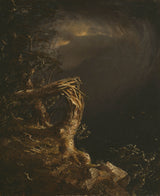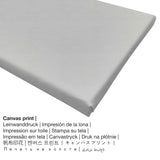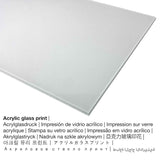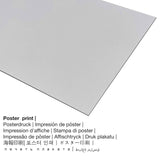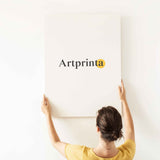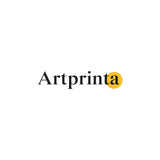Jasper Francis Cropsey, 1850 - Osisi gbawara agbawa - mbipụta nka mara mma
Ụtụ gụnyere. Mbupu gbakọrọ na ndenye ọpụpụ.
"Blasted Tree" was painted by the artist Jasper Francis Cropsey. The original was painted with the absolute size of 43,2 × 35,6 cm (17 × 14 na). Oil on canvas was applied by the painter as the technique for the artpiece. What is more, the artwork is included in the Ụlọ ọrụ Art nke Chicago nchịkọta dijitalụ, nke bụ otu n'ime nnukwu ụlọ ngosi ihe nka nka n'ụwa, na-ebikọ mkpokọta nke gafere ọtụtụ narị afọ na ụwa. Site n'ikike nke: Ụlọ ọrụ Art Chicago (nwere ikike - ngalaba ọha). : Gift of Jamee J. and Marshall Field. In addition to this, the alignment is in portrait format and has a ratio of 1: 1.2, which implies that the length is 20% shorter than the width. The painter Jasper Francis Cropsey was a North American artist, whose artistic style can be classified as Realism. The North American artist lived for 77 afọ, amuru na 1823 in Rossville, Staten Island, New York, New York, United States, neighborhood and deceased in 1900.
Nhọrọ akụrụngwa ngwaahịa gị
Anyị na-enye ihe dị iche iche dị iche iche na nha maka ngwaahịa ọ bụla. Ị nwere ike ịhọrọ nha na ihe kachasị amasị gị n'ime nhọrọ ndị a:
- Mbipụta iko acrylic (nke nwere ezigbo mkpuchi iko): A glossy print on acrylic glass, which is sometimes named as a an art print on plexiglass, will transform your favorite original artwork into marvellous décor. What is more, it offers a distinct alternative to aluminium or canvas prints. The major advantage of an acrylic glass fine art copy is that contrasts and minor artwork details become recognizeable thanks to the delicate tonal gradation in the picture. Our acrylic glass protects your chosen art replica against light and external influences for many decades.
- Mbipụta kanvas: A UV printed canvas applied on a wooden frame. A canvas print of this artwork will allow you to transform your fine art print into a large work of art as you would see in a gallery. How can I hang a canvas print on my wall? The advantage of canvas prints is that they are relatively low in weight, which implies that it is quite simple to hang the Canvas print without the support of extra wall-mounts. Therefore, a canvas print is suitable for any type of wall.
- Akwụkwọ mmado na ihe kwaaji: The poster is a UV printed canvas paper with a slight texture on the surface, which reminds the original masterpiece. Please bear in mind, that depending on the absolute size of the canvas poster print we add a white margin of approximately 2-6cm round about the artwork, which facilitates the framing with your custom frame.
- Mbipụta nke aluminom: Aluminium Dibond prints are prints on metal with a true depth effect. A non-reflective surface structure creates a contemporary look. A direct Aluminium Dibond Print is your excellent start to the sophisticated world of fine art reproductions on aluminum. For the Aluminium Dibond print, we print your artpiece right on the surface of the aluminum.
Ozi dị mkpa: We try whatever we can in order to depict our art products as clearly as possible and to demonstrate them visually. Nevertheless, the pigments of the print materials, as well as the imprint can vary somehwat from the representation on your monitor. Depending on the screen settings and the quality of the surface, not all color pigments can be printed as realisitcally as the digital version depicted here. Given that all are processed and printed manually, there might also be minor variations in the motif's exact position and the size.
Ngwaahịa a
| Nkewa ngwaahịa: | nka nka |
| Usoro mmeputakwa: | dijitalụ mmeputakwa |
| Usoro mmepụta: | mbipụta dijitalụ |
| Mmalite nke ngwaahịa a: | arụpụtara na Germany |
| Stockdị ngwaahịa: | mmepụta ihe na-achọ |
| Eji ngwaahịa a chọrọ: | foto mgbidi, mma mgbidi |
| Ndozi onyonyo a: | usoro eserese |
| Oke akụkụ onyonyo: | 1: 1.2 |
| Pụtara nha akụkụ onyonyo: | ogologo bụ 20% mkpụmkpụ karịa obosara |
| Nhọrọ akụrụngwa: | ígwè ebipụta (aluminium dibond), acrylic glass print (nwere ezigbo mkpuchi iko), mbipụta akwa akwa, mbipụta akwụkwọ mmado (akwụkwọ kwaaji) |
| Nhọrọ nke akwa akwa n'elu etiti ihe ndọtị (mbipụta akwa akwa): | 50x60cm - 20x24", 100x120cm - 39x47", 150x180cm - 59x71" |
| Mbipụta iko acrylic (nke nwere ezigbo mkpuchi iko): | 50x60cm - 20x24", 100x120cm - 39x47", 150x180cm - 59x71" |
| Mbipụta akwụkwọ mmado (akwụkwọ kwaaji): | 50x60cm - 20x24", 100x120cm - 39x47" |
| Mpempe aluminom (aluminium dibond ihe) nha: | 50x60cm - 20x24", 100x120cm - 39x47" |
| ụba: | mbipụta nka na-enweghị isi |
Nkọwa gbasara ọrụ nka mbụ
| Aha nke ọrụ nka: | "Blasted Tree" |
| Nhazi nke ọrụ nka: | sere |
| Otu sara mbara: | nkà nke oge a |
| Narị afọ nka: | 19th narị afọ |
| Emepụtara n'afọ: | 1850 |
| Afọ nka: | ihe dị ka afọ 170 |
| Ọkara nke ihe osise izizi: | mmanụ na kwaaji |
| Akụkụ izizi nka: | 43,2 × 35,6 cm (17 × 14 na) |
| Ụlọ ihe ngosi nka / mkpokọta: | Ụlọ ọrụ Art Chicago |
| Ebe ebe ngosi nka: | Chicago, Illinois, Njikota Obodo Amerika |
| Weebụsaịtị ihe ngosi nka: | Ụlọ ọrụ Art Chicago |
| License: | ngalaba ọha |
| Site n'aka: | Ụlọ ọrụ Art Chicago |
| Ebe kredit nke ọrụ nka: | Onyinye nke Jamee J. na Marshall Field |
Tebụl metadata omenkà
| Aha onye nka: | Jasper Francis Cropsey |
| Aha ndi ozo: | Jasper Francis Cropsey, cropsey jasper, jasper f. cropsey, Jasper Charles Cropsey, Cropsey, Cropsey Jasper Charles, Cropsey Jasper F., Cropsey Jasper Francis, jasper cropsey |
| okike nke onye nka: | nwoke |
| Nationality: | American |
| Ọrụ: | onye na-ese ihe |
| Country: | United States |
| Nhazi nke onye nka: | omenkà nke oge a |
| Ụdị nke onye na-ese ihe: | Ihe ngosi |
| Akwụsị: | 77 afọ |
| Afọ ọmụmụ: | 1823 |
| Ebe amụrụ onye: | Rossville, Staten Island, New York, New York, United States, agbataobi |
| Afọ nwụrụ: | 1900 |
| Nwụrụ na (ebe): | Hastings-on-Hudson, Westchester County, New York steeti, Njikota Obodo Amerika |
Ederede a bụ ikike ọgụgụ isi ma chekwaa ya site na nwebisiinka © - Artprinta.com (Artprinta)
Ozi nkowa mgbakwunye by the museum (© Nwebiisinka - nke Art Institute Chicago - Ụlọ ọrụ Art Chicago)
Like his fellow Hudson River School landscapists, Jasper Cropsey sketched in nature and then combined motifs he had observed into his compositions in his New York studio. In the late 1840s and early 1850s he traveled frequently to the Catskills, where he produced this oil sketch. Here, the gnarled trunk and branches of the weather-beaten tree offered the artist interesting variations of color, tone, and line. Cropsey often included such old trees in his paintings in emulation of Thomas Cole, whom he greatly admired. In Cropsey’s work, as in that of Cole, the subject introduces a sense of time and history into the scene, as well as conveying the sublime power of nature.

